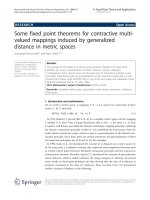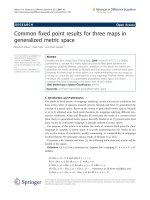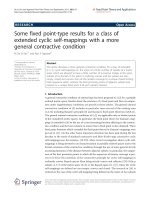Báo cáo hóa học: " SEVERAL FIXED POINT THEOREMS CONCERNING τ-DISTANCE" pot
Bạn đang xem bản rút gọn của tài liệu. Xem và tải ngay bản đầy đủ của tài liệu tại đây (570.27 KB, 15 trang )
SEVERAL FIXED POINT THEOREMS
CONCERNING τ-DISTANCE
TOMONARI SUZUKI
Received 21 October 2003 and in revised form 10 March 2004
Using the notion of τ-distance, we prove several fixed point theorems, which are general-
izations of fixed point theorems by Kannan, Meir-Keeler, Edelstein, and Nadler. We also
discuss the properties of τ-distance.
1. Introduction
In 1922, Banach proved the following famous fixed point theorem [1]. Let (X,d)bea
complete metric space. Let T be a contractive mapping on X, that is, there exists r
∈ [0,1)
satisfying
d(Tx,Ty) ≤ rd(x, y) (1.1)
for all x, y ∈ X. Then there exists a unique fixed point x
0
∈ X of T. This theorem, called
the Banach contraction principle, is a forceful tool in nonlinear analysis. This princi-
ple has many applications and is extended by several authors: Caristi [2], Edelstein [5],
Ekeland [6, 7], Meir and Keeler [14], Nadler [15], and others. These t heorems are also
extended; see [4, 9, 10, 13, 23, 25, 26, 27] and others. In [20], the author introduced
the notion of τ-distance and extended the Banach contraction principle, Caristi’s fixed
point theorem, and Ekeland’s ε-variational principle. In 1969, Kannan proved the follow-
ing fixed point theorem [12]. Let (X,d) be a complete metric space. Let T be a Kannan
mapping on X, that is, there exists α
∈ [0,1/2) such that
d(Tx,Ty) ≤ α
d(Tx,x)+d(Ty, y)
(1.2)
for all x, y ∈ X. Then there exists a unique fixed point x
0
∈ X of T. We note that Kan-
nan’s fixed point theorem is not an extension of the Banach contraction principle. We
also know that a metric space X is complete if and only if every Kannan mapping has
a fixed point, while there exists a metric space X such that X is not complete and every
contractive mapping on X has a fixed point; see [3, 17].
Copyright © 2004 Hindawi Publishing Corporation
Fixed Point Theory and Applications 2004:3 (2004) 195–209
2000 Mathematics Subject Classification: 54H25, 54E50
URL: />196 Fixed point theorems concerning τ-distance
In this paper, using the notion of τ-distance, we prove several fixed point theorems,
which are generalizations of fixed point theorems by Kannan, Meir-Keeler, Edelstein, and
Nadler. We also discuss the properties of τ-distance.
2. τ-distance
Throughout this paper, we denote by N the set of all positive integers. In this section, we
discuss some properties of τ-distance. Let (X,d) be a metric space. Then a function p
from X × X into [0,∞)iscalledaτ-distance on X [20] if there exists a function η from
X × [0,∞)into[0,∞) and the following are satisfied:
(τ1) p(x,z) ≤ p(x, y)+p(y,z)forallx, y, z ∈ X;
(τ2) η(x,0) = 0andη(x,t) ≥ t for all x ∈ X and t ∈ [0,∞), and η is concave and con-
tinuous in its second variable;
(τ3) lim
n
x
n
= x and lim
n
sup{η(z
n
, p(z
n
,x
m
)) : m ≥ n}=0implyp(w,x) ≤
liminf
n
p(w,x
n
)forallw ∈ X;
(τ4) lim
n
sup{p(x
n
, y
m
):m ≥ n}=0andlim
n
η(x
n
,t
n
) = 0 imply lim
n
η(y
n
,t
n
) = 0;
(τ5) lim
n
η(z
n
, p(z
n
,x
n
)) = 0andlim
n
η(z
n
, p(z
n
, y
n
)) = 0 imply lim
n
d(x
n
, y
n
) = 0.
We may replace (τ2) by the following (τ2)
(see [20]):
(τ2)
inf{η(x, t):t>0}=0forallx ∈ X,andη is nondecreasing in its second variable.
The metric d is a τ-distance on X. Many useful examples are stated in [11, 16, 18, 19, 20,
21, 22, 24]. It is very meaningful that one τ-distance generates other τ-distances. In the
sequel, we discuss this fact.
Proposition 2.1. Let (X,d) be a metric space. Let p be a τ-distance on X and let η be a
function satisfying (τ2)
,(τ3), (τ4), and (τ5). Let q be a function from X × X into [0,∞)
satisfying (τ1)
q
.Supposethat
(i) there exists c>0 such that min{p(x, y),c}≤q(x, y) for x, y ∈ X,
(ii) lim
n
x
n
=x and lim
n
sup{η(z
n
,q(z
n
,x
m
)) : m≥n}=0 imply q(w, x)≤ liminf
n
q(w,x
n
)
for w ∈ X.
Then q is also a τ-distance on X.
Proof. We p ut
θ(x,t) = t + η(x, t) (2.1)
for x ∈ X and t ∈ [0,∞). Note that η(x,t) ≤ θ(x,t)forallx ∈ X and t ∈ [0,∞). Then,
by the assumption, (τ1)
q
,(τ2)’
θ
,and(τ3)
q,θ
hold. We assume that lim
n
sup{q(x
n
, y
m
):
m ≥ n}=0andlim
n
θ(x
n
,t
n
) = 0. Then lim
n
sup{p(x
n
, y
m
):m ≥ n}=0andlim
n
t
n
=
lim
n
η(x
n
,t
n
) = 0 clearly hold. From (τ4), we have lim
n
η(y
n
,t
n
) = 0 and hence
lim
n
θ(y
n
,t
n
) = 0. Therefore, we have shown (τ4)
q,θ
. We assume that lim
n
θ(z
n
,q(z
n
,x
n
))=
0andlim
n
θ(z
n
,q(z
n
, y
n
)) = 0. By the definition of θ,wehavelim
n
η(z
n
,q(z
n
,x
n
)) = 0and
lim
n
q(z
n
,x
n
) = 0. So, by the assumption, lim
n
η(z
n
, p(z
n
,x
n
)) = 0 holds. We can similarly
prove lim
n
η(z
n
, p(z
n
, y
n
)) = 0. Therefore, from (τ5), lim
n
d(x
n
, y
n
) = 0. Hence, we have
shown (τ5)
q,θ
. This completes the proof.
As a direct consequence of Proposition 2.1, we obtain the following proposition.
Tomonari Suzuki 197
Proposition 2.2. Let p be a τ-distance on a metric space X.Letq beafunctionfromX × X
into [0,∞) satisfying (τ1)
q
.Supposethat
(i) there exists c>0 such that min{p(x, y),c}≤q(x, y) for x, y ∈ X,
(ii) for every convergent sequence {x
n
} with limit x satisfying p(w,x) ≤ liminf
n
p(w,x
n
)
for all w ∈ X, q(w,x) ≤ liminf
n
q(w,x
n
) holds for all w ∈ X.
Then q is also a τ-distance on X.
Using the above proposition, we obtain the following one w hich is used in the proof
of generalized Kannan’s fixed point theorem.
Proposition 2.3. Let p be a τ-distance on a metric space X and let α be a function from X
into [0,∞).Thentwofunctionsq
1
and q
2
from X × X into [0,∞),definedby
(i) q
1
(x, y) = max{α(x), p(x, y)} for x, y ∈ X,
(ii) q
2
(x, y) = α(x)+p(x, y) for x, y ∈ X,
are τ-distances on X.
Proof. We h ave
q
1
(x, z) = max
α(x), p(x,z)
≤ max
α(x)+α(y), p(x, y)+p(y,z)
≤ q
1
(x, y)+q
1
(y,z),
q
2
(x, z) = α(x)+p(x,z)
≤ α(x)+α(y)+p(x, y)+p(y,z)
= q
2
(x, y)+q
2
(y,z),
(2.2)
for all x, y,z ∈ X. We note that
p(x, y) ≤ q
1
(x, y) ≤ q
2
(x, y) (2.3)
for all x, y ∈ X.Weassumethatasequence{x
n
} satisfies lim
n
x
n
= x and p(w,x) ≤
liminf
n
p(w,x
n
)forallw ∈ X. Then it is clear that q
1
(w,x) ≤ liminf
n
q
1
(w,x
n
)and
q
2
(w,x) ≤ liminf
n
q
2
(w,x
n
)forallw ∈ X.ByProposition 2.2, q
1
and q
2
are τ-distances
on X. This completes the proof.
Let (X,d) be a metric space and let p be a τ-distance on X. Then a sequence {x
n
} in
X is called p-Cauchy [20] if there exist a function η from X × [0,∞)into[0,∞) satisfying
(τ2)–(τ5) and a sequence {z
n
} in X such that lim
n
sup{η(z
n
, p(z
n
,x
m
)) : m ≥ n}=0. The
following lemmas are very useful in the proofs of fixed point theorems in Section 3.
Lemma 2.4 [20]. Let (X,d) be a metric space and let p be a τ-distance on X.If{x
n
} is
a p-Cauchy sequence, then {x
n
} is a Cauchy sequence. Moreover, if {y
n
} is a sequence
satisfying lim
n
sup{p(x
n
, y
m
):m ≥ n}=0, then {y
n
} is also a p-Cauchy sequence and
lim
n
d(x
n
, y
n
) = 0.
Lemma 2.5 [20]. Let (X,d) be a metric space and let p be a τ-distance on X.Ifasequence
{x
n
} in X satisfies lim
n
p(z,x
n
) = 0 for some z ∈ X, then {x
n
} is a p-Cauchy sequence.
198 Fixed point theorems concerning τ-distance
Moreover, if a sequence {y
n
} in X also satisfies lim
n
p(z, y
n
) = 0, then lim
n
d(x
n
, y
n
) = 0.In
particular, for x, y,z ∈ X, p(z,x) = 0 and p(z, y) = 0 imply x = y.
Lemma 2.6 [20]. Let (X,d) be a metric space and let p be a τ-distance on X.Ifase-
quence
{x
n
} in X satisfies lim
n
sup{p(x
n
,x
m
):m>n}=0, then {x
n
} is a p-Cauchy se-
quence. Moreover, if a sequence {y
n
} in X satisfies lim
n
p(x
n
, y
n
) = 0, then {y
n
} is also a
p-Cauchy sequence and lim
n
d(x
n
, y
n
) = 0.
3. Fixed point theorems
In this section, we prove several fixed point theorems in complete metric spaces. In [20],
the following theorem connected with Hicks-Rhoades theorem [8] was proved and used
in the proofs of generalizations of the Banach contraction pr inciple, Caristi’s fixed point
theorem, and so on. In this paper, this theorem is used in the proof of a generalization of
Kannan’s fixed point theorem.
Theorem 3.1 [20]. Let X be a complete metric space and let T be a mapping on X.Suppose
that there exist a τ-distance p on X and r ∈ [0,1) such that p(Tx,T
2
x) ≤ rp(x,Tx) for all
x ∈ X. Assume that either of the following holds:
(i) if lim
n
sup{p(x
n
,x
m
):m>n}=0, lim
n
p(x
n
,Tx
n
) = 0,andlim
n
p(x
n
, y) = 0, then
Ty= y;
(ii) if {x
n
} and {Tx
n
} converge to y, then Ty= y;
(iii) T is continuous.
Then there exists x
0
∈ X such that Tx
0
= x
0
.Moreover,ifTz = z, then p(z, z) = 0.
As a direct consequence, we obtain the following theorem.
Theorem 3.2. Let X be a complete metric space and let p be a τ-distance on X.LetT be a
mapping on X. Suppose that there exists r
∈ [0,1) such that either (a) or (b) holds:
(a) max{p(T
2
x, Tx), p(Tx,T
2
x)}≤r max{p(Tx,x), p(x,Tx)} for all x ∈ X;
(b) p(T
2
x, Tx)+p(Tx,T
2
x) ≤ rp(Tx,x)+rp(x, Tx) for all x ∈ X.
Further, assume that either of the following holds:
(i) if lim
n
sup{p(x
n
,x
m
):m>n}=0, lim
n
p(Tx
n
,x
n
) = 0, lim
n
p(x
n
,Tx
n
) = 0,and
lim
n
p(x
n
, y) = 0, then Ty= y;
(ii) if {x
n
} and {Tx
n
} converge to y, then Ty= y;
(iii) T is continuous.
Then there exists x
0
∈ X such that Tx
0
= x
0
.Moreover,ifTz = z, then p(z, z) = 0.
Proof. In the case of (a), we define a function q by q(x, y) = max{p(Tx,x), p(x, y)}.In
the case of (b), we define a function q by q(x, y) = p(Tx,x)+p(x, y). By Proposition 2.3,
q is a τ-distance on X. In both cases, we have
q
Tx,T
2
x
≤ rq(x,Tx) (3.1)
Tomonari Suzuki 199
for all x ∈ X. Conditions (ii) and (iii) are not connected with τ-distance p. In the case of
(i), since
p(x, y) ≤ q(x, y), p(Tx,x) ≤ q(x,Tx), (3.2)
for all x, y ∈ X, T has a fixed point in X by Theorem 3.1.IfTz = z,thenq(z,z) = 0, and
hence p(z,z) = 0. This completes the proof.
We now prove a generalization of Kannan’s fixed point theorem [12]. Let X be a metric
space, let p be a τ-distance on X,andletT be a mapping on X.ThenT is called a Kannan
mapping with respect to p if there exists α ∈ [0,1/2) such that either (a) or (b) holds:
(a) p(Tx,Ty) ≤ αp(Tx,x)+αp(Ty, y)forallx, y ∈ X;
(b) p(Tx,Ty) ≤ αp(Tx,x)+αp(y,Ty)forallx, y ∈ X.
Theorem 3.3. Let (X,d) be a complete metric space, let p be a τ-distance on X,andletT be
a Kannan mapping on X with respect to p. Then T has a unique fixed point x
0
∈ X.Further,
such x
0
satisfies p(x
0
,x
0
) = 0.
Proof. In the case of (a), there exists α ∈ [0,1/2) such that p(Tx,Ty) ≤ αp(Tx,x)+
αp(Ty, y)forx, y ∈ X.Since
p
T
2
x, Tx
≤ αp
T
2
x, Tx
+ αp(Tx,x), (3.3)
we have
p
T
2
x, Tx
≤
α
1 − α
p(Tx,x) ≤ p(Tx,x) (3.4)
for x ∈ X.Puttingr = 2α ∈ [0,1), we have
max
p
T
2
x, Tx
, p
Tx,T
2
x
≤ αp
T
2
x, Tx
+ αp(Tx,x)
≤ rp(Tx,x)
≤ r max
p(Tx,x), p(x,Tx)
(3.5)
for all x ∈ X.Weassumelim
n
sup{p(x
n
,x
m
):m>n}=0, lim
n
p(Tx
n
,x
n
) = 0,
lim
n
p(x
n
,Tx
n
) = 0, and lim
n
p(x
n
, y) = 0. Then, by Lemma 2.6, {x
n
} and {Tx
n
} are p-
Cauchy and
lim
n→∞
d
x
n
, y
=
lim
n→∞
d
Tx
n
, y
=
0. (3.6)
Now we have
p(Ty, y) ≤ liminf
n→∞
p
Ty,Tx
n
≤ liminf
n→∞
αp(Ty, y)+αp
Tx
n
,x
n
= αp(Ty, y),
(3.7)
200 Fixed point theorems concerning τ-distance
and hence p(Ty, y) = 0. Since p(T
2
y,Ty) ≤ p(Ty, y) = 0andp(T
2
y, y) ≤ p(T
2
y,Ty)+
p(Ty, y) = 0, we have Ty = y by Lemma 2.5. Therefore, by Theorem 3.2, there exists
x
0
∈ X such that Tx
0
= x
0
and p(x
0
,x
0
) = 0. Further, a fixed point of T is unique. In fact,
if Tz = z,thenp(z,z) = 0byTheorem 3.2.Sowehave
p
x
0
,z
= p
Tx
0
,Tz
≤ αp
Tx
0
,x
0
+ αp(Tz,z)
= αp
x
0
,x
0
+ αp(z,z) = 0.
(3.8)
By Lemma 2.5 again, we have x
0
= z. In the case of (b), there exists α ∈ [0,1/2) such that
p(Tx,Ty)
≤ αp(Tx,x)+αp(y,Ty)forx, y ∈ X. Then, putting r = α/(1 − α) ∈ [0,1), we
have p(Tx,T
2
x) ≤ rp(Tx,x)andp(T
2
x, Tx) ≤ rp(x,Tx)forallx ∈ X.So,
p
T
2
x, Tx
+ p
Tx,T
2
x
≤ rp(Tx,x)+rp(x,Tx)
(3.9)
for all x ∈ X.Weassumelim
n
sup{p(x
n
,x
m
):m>n}=0, lim
n
p(Tx
n
,x
n
) = 0, lim
n
p(x
n
,
Tx
n
) = 0, and lim
n
p(x
n
, y) = 0. Then {x
n
} and {Tx
n
} are p-Cauchy and lim
n
d(x
n
, y) =
lim
n
d(Tx
n
, y) = 0. So we have
p(Ty, y) ≤ liminf
n→∞
p
Ty,Tx
n
≤ liminf
n→∞
αp(Ty, y)+αp
x
n
,Tx
n
= αp(Ty, y),
(3.10)
and hence p(Ty, y) = 0. Since p(Ty,T
2
y) ≤ rp(Ty, y) = 0, we have y = T
2
y by Lemma
2.5.So,p(y,Ty)= p(T
2
y,Ty)≤rp(y, Ty), and hence p(y,Ty)=0. We also have p(y, y)≤
p(y, Ty)+p(Ty, y) = 0. So we have Ty = y by Lemma 2.5. Therefore, by Theorem 3.2,
there exists x
0
∈ X such that Tx
0
= x
0
and p(x
0
,x
0
) = 0. As in the case of (a), we obtain
that a fixed point of T is unique.
In general, τ-distance p does not satisfy p(x, y) = p(y,x). So conditions (a) and (b)
in the definition of Kannan mappings differ from conditions (c) and (d) in the following
theorem. Indeed, there exists a mapping T on a complete metric space X such that (c)
and (d) hold, and T has no fixed points; see [19]. However, under the assumption that T
is continuous, T has a fixed point.
Theorem 3.4. Let X be a complete metric space and let T be a continuous mapping on X.
Suppose that there exist a τ-distance p on X and α
∈ [0,1/2) such that either (c) or (d)
holds:
(c) p(Tx,Ty) ≤ αp(x,Tx)+αp(Ty, y) for all x, y ∈ X;
(d) p(Tx,Ty) ≤ αp(x,Tx)+αp(y,Ty) for all x, y ∈ X.
Then there exists a unique fixed point x
0
∈ X of T.Moreover,suchx
0
satisfies p(x
0
,x
0
) = 0.
Proof. In the case of (c), putting r = α/(1 − α) ∈ [0,1), from p(Tx,T
2
x) ≤ αp(x,Tx)+
αp(T
2
x, Tx)andp(T
2
x, Tx) ≤ αp(Tx,T
2
x)+αp(Tx,x), we have
p
T
2
x, Tx
+ p
Tx,T
2
x
≤ rp(Tx,x)+rp(x,Tx) (3.11)
Tomonari Suzuki 201
for all x ∈ X.So,byTheorem 3.2, we prove the desired result. In the case of (d), we have
p(Tx,T
2
x) ≤ rp(x,Tx)forallx ∈ X. Therefore, by Theorem 3.1, we prove the desired
result. This completes the proof.
We next prove a generalization of Meir and Keeler’s fixed point theorem [14].
Theorem 3.5. Let X be a complete metric space, let p be a τ-distance on X,andletT be
a mapping on X.Supposethatforanyε>0,thereexistsδ>0 such that for every x, y ∈ X,
p(x, y) <ε+ δ implies p(Tx,Ty) <ε. Then T has a unique fixed point x
0
in X. Further, such
x
0
satisfies p(x
0
,x
0
) = 0.
Proof. We first show p(Tx,Ty) ≤ p(x, y)forallx, y ∈ X. For an arbitrary λ>0, there
exists δ>0suchthatforeveryz,w ∈ X, p(z,w) <p(x, y)+λ + δ implies p(Tz,Tw) <
p(x, y)+λ.Sincep(x, y) <p(x, y)+λ + δ,wehavep(Tx,Ty) <p(x, y)+λ.Sinceλ>0is
arbitrary, we obtain p(Tx,Ty) ≤ p(x, y). We next show
lim
n→∞
p
T
n
x, T
n
y
=
0 ∀x, y ∈ X. (3.12)
In fact, {p(T
n
x, T
n
y)} is nonincreasing and hence converges to some real number r.We
assume r>0. Then there exists δ>0suchthatforeveryz,w ∈ X, p(z,w) <r+ δ implies
p(Tz,Tw) <r.Forsuchδ,wecanchoosem ∈ N such that p(T
m
x, T
m
y) <r+ δ.Sowe
have p(T
m+1
x, T
m+1
y) <r. This is a contradiction, and hence (3.12)holds.Letu ∈ X and
put u
n
= T
n
u for every n ∈ N.From(3.12), we have lim
n
p(u
n
,u
n+1
) = 0. We will show
that
lim
n→∞
sup
m>n
p
u
n
,u
m
=
0. (3.13)
Let ε>0 be arbitrary. Then, without loss of generality, there exists δ
∈ (0,ε)suchthat
for every z,w ∈ X, p(z,w) <ε+ δ implies p(Tz,Tw) <ε.Forsuchδ, there exists n
0
∈ N
such that p(u
n
,u
n+1
) <δfor every n ≥ n
0
. Assume that there exists m>≥ n
0
such that
p(u
,u
m
) > 2ε.Since
p
u
,u
+1
<ε+ δ<p
u
,u
m
, (3.14)
there exists k ∈ N with <k<msuch that
p
u
,u
k
<ε+ δ ≤ p
u
,u
k+1
. (3.15)
Then, since p(u
,u
k
) <ε+ δ,wehavep(u
+1
,u
k+1
) <ε. On the other hand, we have
p
u
,u
k+1
≤ p
u
,u
+1
+ p
u
+1
,u
k+1
<δ+ ε. (3.16)
This is a contradiction. Therefore, m>n≥ n
0
implies p(u
n
,u
m
) ≤ 2ε, and hence (3.13)
holds. By Lemma 2.6, {u
n
} is p-Cauchy. So, {u
n
} is also a Cauchy sequence by Lemma 2.4.
202 Fixed point theorems concerning τ-distance
Hence there exists x
0
∈ X such that {u
n
} converges to x
0
.From(τ3), we have
limsup
n→∞
p
u
n
,Tx
0
≤ limsup
n→∞
p
u
n−1
,x
0
=
limsup
n→∞
p
u
n
,x
0
≤ limsup
n→∞
liminf
m→∞
p
u
n
,u
m
≤ lim
n→∞
sup
m>n
p
u
n
,u
m
=
0.
(3.17)
By Lemma 2.6 again, {u
n
} converges to Tx
0
, and hence Tx
0
= x
0
.From(3.12), we obtain
p
x
0
,x
0
= lim
n→∞
p
T
n
x
0
,T
n
x
0
= 0. (3.18)
If z
= Tz,then
p
x
0
,z
= lim
n→∞
p
T
n
x
0
,T
n
z
= 0. (3.19)
So, from Lemma 2.5, x
0
= z. Therefore, a fixed point of T is unique. This completes the
proof.
Let X be a metric space and let p be a τ-distance on X.Forε ∈ (0, ∞], X is called
ε-chainable with respect to p if, for each (x, y) ∈ X × X, there exists a finite sequence
{u
0
,u
1
,u
2
, ,u
} in X such that u
0
= x, u
= y,andp(u
i−1
,u
i
) <εfor i = 1,2, ,.We
will prove a generalization of Edelstein’s fixed point theorem [5].
Theorem 3.6. Let X be a complete metric space. Suppose that X is ε-chainable with respect
to p for some ε
∈ (0,∞] and for some τ-distance p on X.LetT be a mapping on X.Suppose
that there exists r ∈ [0,1) such that p(Tx,Ty) ≤ rp(x, y) for all x, y ∈ X with p(x, y) <ε.
Then there exists a unique fixed point x
0
∈ X of T. Further, such x
0
satisfies p(x
0
,x
0
) = 0.
Proof. We first show
lim
n→∞
p
T
n
x, T
n
y
=
0 (3.20)
for all x, y ∈ X.Letx, y ∈ X be fixed. Then there exist u
0
,u
1
,u
2
, ,u
∈ X such that u
0
=
x, u
= y,andp(u
i−1
,u
i
)<εfor i = 1,2, ,.Sincep(u
i−1
,u
i
) <ε,wehavep(Tu
i−1
,Tu
i
) ≤
rp(u
i−1
,u
i
) <ε.Thus
p
T
n
u
i−1
,T
n
u
i
≤ rp
T
n−1
u
i−1
,T
n−1
u
i
≤··· ≤r
n
p
u
i−1
,u
i
. (3.21)
Therefore
limsup
n→∞
p
T
n
x, T
n
y
≤ limsup
n→∞
i=1
p
T
n
u
i−1
,T
n
u
i
≤ lim
n→∞
i=1
r
n
p
u
i−1
,u
i
= 0.
(3.22)
Tomonari Suzuki 203
We have shown (3.20). Let x ∈ X be fixed. From (3.20), there exists n
0
∈ N such that
p
T
n
x, T
n+1
x
<ε (3.23)
for n ≥ n
0
.Then,form>n≥ n
0
,wehave
p
T
n
x, T
m
x
≤
m−1
k=n
p
T
k
x, T
k+1
x
≤
m−1
k=n
r
k−n
0
p
T
n
0
x, T
n
0
+1
x
≤
r
n−n
0
1 − r
p
T
n
0
x, T
n
0
+1
x
.
(3.24)
Hence, lim
n
sup{p(T
n
x, T
m
x):m>n}=0. By Lemma 2.6, {T
n
x} is p-Cauchy. By Lemma
2.4, {T
n
x} is a Cauchy sequence. So, {T
n
x} converges to some x
0
∈ X.Since
limsup
n→∞
p
T
n
x, x
0
≤ limsup
n→∞
liminf
m→∞
p
T
n
x, T
m
x
≤ lim
n→∞
sup
m>n
p
T
n
x, T
m
x
= 0,
(3.25)
we have
limsup
n→∞
p
T
n
x, Tx
0
≤ lim
n→∞
rp
T
n−1
x, x
0
=
0. (3.26)
By Lemma 2.6,weobtainTx
0
= x
0
.Ifz is a fixed point of T,thenwehave
p
x
0
,z
=
lim
n→∞
p
T
n
x
0
,T
n
z
=
0 (3.27)
from (3.20). We also have p(x
0
,x
0
) = 0. Therefore, z = x
0
by Lemma 2.5. This completes
the proof.
Let X be a metric space and let p be a τ-distance on X. Then, a set-valued mapping T
from X into itself is called p-contractive if Tx is nonempty for each x ∈ X and there exists
r ∈ [0,1) such that
Q(Tx,Ty) ≤ rp(x, y) (3.28)
for all x, y ∈ X,where
Q(A,B) = sup
a∈A
inf
b∈B
p(a, b). (3.29)
The following theorem is a generalization of Nadler’s fixed point theorem [15].
Theorem 3.7. Let (X,d) be a complete metric space and let p be a τ-distance on X.LetT
be a set-valued p-contractive mapping from X into itself such that for any x
∈ X, Tx is a
nonempty closed subset of X. Then there exists x
0
∈ X such that x
0
∈ Tx
0
and p(x
0
,x
0
) = 0.
204 Fixed point theorems concerning τ-distance
Remark 3.8. z ∈ Tz does not necessarily imply p(z,z) = 0; see Example 3.9.
Proof. By the assumption, there exists r
∈ [0,1) such that Q(Tx,Ty) ≤ r
p(x, y)forall
x, y ∈ X.Putr = (1 + r
)/2 ∈ [0,1) and fix x, y ∈ X and u ∈ Tx. Then, in the case of
p(x, y) > 0, there is v
∈ Ty satisfying p(u,v) ≤ rp(x, y). In the case of p(x, y) = 0, we
have Q(Tx,Ty) = 0. Then there exists a sequence {v
n
} in Ty satisfying lim
n
p(u, v
n
) = 0.
By Lemma 2.5, {v
n
} is p-Cauchy, and hence {v
n
} is Cauchy. Since X is complete and Ty
is closed, {v
n
} converges to some point v ∈ Ty.Thenwehave
p(u, v) ≤ lim
n→∞
p
u,v
n
= 0 = rp(x, y). (3.30)
Hence, we have shown that for any x, y ∈ X and u ∈ Tx, there is v ∈ Ty with p(u,v) ≤
rp(x, y). Fix u
0
∈ X and u
1
∈ Tu
0
. Then there exists u
2
∈ Tu
1
such that p(u
1
,u
2
) ≤
rp(u
0
,u
1
). Thus, we have a sequence {u
n
} in X such that u
n+1
∈ Tu
n
and p(u
n
,u
n+1
) ≤
rp(u
n−1
,u
n
)foralln ∈ N.Foranyn ∈ N,wehave
p
u
n
,u
n+1
≤ rp
u
n−1
,u
n
≤ r
2
p
u
n−2
,u
n−1
≤··· ≤r
n
p
u
0
,u
1
, (3.31)
and hence, for any m,n
∈ N with m>n,
p
u
n
,u
m
≤ p
u
n
,u
n+1
+ p
u
n+1
,u
n+2
+ ···+ p
u
m−1
,u
m
≤ r
n
p
u
0
,u
1
+ r
n+1
p
u
0
,u
1
+ ···+ r
m−1
p
u
0
,u
1
≤
r
n
1 − r
p
u
0
,u
1
.
(3.32)
By Lemma 2.6, {u
n
} is a p-Cauchy sequence. Hence, by Lemma 2.4, {u
n
} is a Cauchy
sequence. So, {u
n
} converges to some point v
0
∈ X.Forn ∈ N,from(τ3), we have
p
u
n
,v
0
≤ liminf
m→∞
p
u
n
,u
m
≤
r
n
1 − r
p
u
0
,u
1
. (3.33)
By hypothesis, we also have w
n
∈ Tv
0
such that p(u
n
,w
n
) ≤ rp(u
n−1
,v
0
)forn ∈ N.Sowe
have
limsup
n→∞
p
u
n
,w
n
≤ limsup
n→∞
rp
u
n−1
,v
0
≤ lim
n→∞
r
n
1 − r
p
u
0
,u
1
=
0.
(3.34)
By Lemma 2.6,
{w
n
} converges to v
0
.SinceTv
0
is closed, we have v
0
∈ Tv
0
.Forsuchv
0
,
there exists v
1
∈ Tv
0
such that p(v
0
,v
1
) ≤ rp(v
0
,v
0
). Thus, we also have a sequence {v
n
}
in X such that v
n+1
∈ Tv
n
and p(v
0
,v
n+1
) ≤ rp(v
0
,v
n
)foralln ∈ N.Sowehave
p
v
0
,v
n
≤ rp
v
0
,v
n−1
≤··· ≤r
n
p
v
0
,v
0
. (3.35)
Hence
limsup
n→∞
p
u
n
,v
n
≤ lim
n→∞
p
u
n
,v
0
+ p
v
0
,v
n
= 0. (3.36)
Tomonari Suzuki 205
By Lemma 2.6 again, {v
n
} is a p-Cauchy sequence and converges to v
0
.Sowehave
p
v
0
,v
0
≤ lim
n→∞
p
v
0
,v
n
=
0. (3.37)
This completes the proof.
Example 3.9. Put X ={0,1} and define a τ-distance p on X by p(x, y) = y for a ll x, y ∈ X,
and a set-valued p-contractive mapping T from X into itself by T(x) = X for all x ∈ X.
Then 1 ∈ X is a fixed point of T and p(1,1) = 0.
4. Other examples of τ-distances
In this section, we give other examples of τ-distances gener ated by either some τ-distance
p or a family of τ-distances.
Proposition 4.1. Let p be a τ-distance on a metric space X.Fixc>0.Defineafunctionq
from X × X into [0,∞) by
q(x, y)
= min
p(x, y),c
(4.1)
for x, y ∈ X. Then q is also a τ-distance on X.
Proof. Fix x, y,z ∈ X. In the case of p(x, y) <cand p(y,z) <c,wehave
q(x,z) ≤ p(x, z) ≤ p(x, y)+p(y,z) = q(x, y)+q(y,z). (4.2)
Inthecaseofp(x, y) ≥ c or p(y,z) ≥ c,wehave
q(x,z) ≤ c ≤ q(x, y)+q(y,z). (4.3)
Therefore, we have shown (τ1)
q
.So,byProposition 2.2, we obtain the desired result.
Proposition 4.2. Let (X,d) be a metric space. Let {p
n
} beasequenceofτ-distances on X.
Then the follow ing hold.
(i) Afunctionq
1
,definedby
q
1
(x, y) = max
p
1
(x, y), p
2
(x, y)
(4.4)
for x, y ∈ X,isaτ-distance on X.
(ii) Afunctionq
2
,definedby
q
2
(x, y) = p
1
(x, y)+p
2
(x, y) (4.5)
for x, y ∈ X,isaτ-distance on X.
(iii) For each c>0,afunctionq
3
,definedby
q
3
(x, y) = min
sup
n∈N
p
n
(x, y),c
(4.6)
for x, y ∈ X,isaτ-distance on X.
206 Fixed point theorems concerning τ-distance
(iv) For each c>0,afunctionq
4
,definedby
q
4
(x, y) = min
∞
n=1
p
n
(x, y),c
(4.7)
for x, y ∈ X,isaτ-distance on X.
(v) If a function q
5
,definedby
q
5
(x, y) = sup
n∈N
p
n
(x, y) (4.8)
for x, y ∈ X, is a real-valued function, then q
5
is a τ-distance on X.
(vi) If a function q
6
,definedby
q
6
(x, y) =
∞
n=1
p
n
(x, y) (4.9)
for x, y ∈ X, is a real-valued function, then q
6
is a τ-distance on X.
Proof. Let
{η
n
} be a sequence of functions satisfying (τ2)
p
n
,η
n
,(τ3)
p
n
,η
n
,(τ4)
p
n
,η
n
,and
(τ5)
p
n
,η
n
for n ∈ N.Wefirstprovethatq
5
is a τ-distance on X.Since
sup
n∈N
p
n
(x, z) ≤ sup
n∈N
p
n
(x, y)+p
n
(y,z)
≤ sup
n∈N
p
n
(x, y)+sup
n∈N
p
n
(y,z), (4.10)
we have q
5
(x, z) ≤ q
5
(x, y)+q
5
(y,z)forx, y,z ∈ X. Define a function θ from X × [0,∞)
into [0,∞)by
θ(x,t) = t +
∞
n=1
2
1−n
min
η
n
(x, t),1
(4.11)
for x ∈ X and t ∈ [0,∞). Fix x∈X.Foranyε>0, we choose k
1
∈N with 1/k
1
+2
1−k
1
<ε/2.
Then there exists t
1
∈ (0,ε/2) satisfying
k
1
n=1
2
1−n
η
n
x, t
1
<
1
k
1
. (4.12)
Hence
θ
x, t
1
<t
1
+
1
k
1
+
∞
n=k
1
+1
2
1−n
min
η
n
x, t
1
,1
≤
ε
2
+
1
k
1
+2
1−k
1
<ε. (4.13)
Therefore, θ(x, ·)iscontinuousat0.Hence,(τ2)
θ
is shown. We suppose lim
n
x
n
= x and
lim
n
sup{θ(z
n
,q
5
(z
n
,x
m
)) : m ≥ n}=0. Then, for any k ∈ N,wehave
limsup
n→∞
sup
m≥n
min
η
k
z
n
, p
k
z
n
,x
m
,1
≤ limsup
n→∞
sup
m≥n
min
η
k
z
n
,q
5
z
n
,x
m
,1
≤
lim
n→∞
sup
m≥n
2
k−1
θ
z
n
,q
5
z
n
,x
m
= 0,
(4.14)
Tomonari Suzuki 207
and hence
lim
n→∞
sup
m≥n
η
k
z
n
, p
k
z
n
,x
m
= 0. (4.15)
From (τ3)
p
k
,η
k
,
p
k
(w,x) ≤ liminf
n→∞
p
k
w,x
n
(4.16)
for all w ∈ X. Therefore, we have
sup
k∈N
p
k
(w,x) ≤ sup
k∈N
liminf
n→∞
p
k
w,x
n
≤ liminf
n→∞
sup
k∈N
p
k
w,x
n
,
(4.17)
and hence q
5
(w,x) ≤ liminf
n
q
5
(w,x
n
)forallw ∈ X. We have shown (τ3)
q
5
,θ
.Weprove
(τ4)
q
5
,θ
. We assume that lim
n
sup{q
5
(x
n
, y
m
):m ≥ n}=0andlim
n
θ(x
n
,t
n
) = 0. Then we
have lim
n
sup{p
k
(x
n
, y
m
):m ≥ n}=0andlim
n
η
k
(x
n
,t
n
) = 0forallk ∈ N.From(τ4)
p
k
,η
k
,
we have lim
n
η
k
(y
n
,t
n
) = 0forallk ∈ N.Foranyε>0, we choose k
2
∈ N with 1/k
2
+
2
1−k
2
<ε/2. Then there exists n
2
∈ N satisfying
k
2
k=1
2
1−k
η
k
y
n
,t
n
<
1
k
2
(4.18)
and t
n
<ε/2forn ≥ n
2
.Wenowhave
θ
y
n
,t
n
≤ t
n
+
1
k
2
+2
1−k
2
<ε (4.19)
for n ≥ n
2
. This implies lim
n
θ(y
n
,t
n
) = 0. We prove (τ5)
q
5
,θ
.Weassumelim
n
θ(z
n
,
q
5
(z
n
,x
n
)) = 0andlim
n
θ(z
n
,q
5
(z
n
, y
n
)) = 0. Then we have
limsup
n→∞
min
η
1
z
n
, p
1
z
n
,x
n
,1
≤ limsup
n→∞
θ
z
n
, p
1
z
n
,x
n
≤ lim
n→∞
θ
z
n
,q
5
z
n
,x
n
=
0,
(4.20)
and hence lim
n
η
1
(z
n
, p
1
(z
n
,x
n
)) = 0. We can similarly prove lim
n
η
1
(z
n
, p
1
(z
n
, y
n
)) = 0.
Therefore, we obtain lim
n
d(x
n
, y
n
) = 0. We have shown that q
5
is a τ-distance on X.We
next prove that q
6
is a τ-distance on X.Since
∞
n=1
p
n
(x, z) ≤
∞
n=1
p
n
(x, y)+p
n
(y,z)
=
∞
n=1
p
n
(x, y)+
∞
n=1
p
n
(y,z), (4.21)
we ha v e q
6
(x, z) ≤ q
6
(x, y)+q
6
(y,z)forx, y,z ∈ X. We note that q
5
(x, y) ≤ q
6
(x, y)for
x, y ∈ X.Wesupposelim
n
x
n
= x and lim
n
sup{θ(z
n
,q
6
(z
n
,x
m
)) : m ≥ n}=0. Then we
208 Fixed point theorems concerning τ-distance
have lim
n
sup{θ(z
n
,q
5
(z
n
,x
m
)) : m ≥ n}=0. In such case, we have already shown that
p
k
(w,x) ≤ liminf
n
p
k
(w,x
n
)forw ∈ X and k ∈ N.Fixλ with
λ<
∞
k=1
liminf
n→∞
p
k
w,x
n
. (4.22)
Then there exist k
3
,n
3
∈ N such that λ<
k
3
k=1
p
k
(w,x
n
)forn ≥ n
3
.Hence
λ ≤ liminf
n→∞
k
3
k=1
p
k
w,x
n
≤ liminf
n→∞
∞
k=1
p
k
w,x
n
. (4.23)
Therefore, we have
∞
k=1
p
k
(w,x) ≤
∞
k=1
liminf
n→∞
p
k
w,x
n
≤ liminf
n→∞
∞
k=1
p
k
w,x
n
, (4.24)
and hence q
6
(w,x) ≤ liminf
n
q
6
(w,x
n
)forw ∈ X.ByProposition 2.1, q
6
is a τ-distance
on X.Since
q
1
(x, y) = sup
p
1
(x, y), p
2
(x, y), p
2
(x, y), p
2
(x, y),
,
q
2
(x, y) = p
1
(x, y)+
1
2
p
2
(x, y)+
1
4
p
2
(x, y)+
1
8
p
2
(x, y)+···,
(4.25)
q
1
and q
2
are τ-distances on X.Since
q
3
(x, y) = sup
n∈N
min
p
n
(x, y),c
,
q
4
(x, y) = sup
n∈N
min
n
k=1
p
k
(x, y),c
,
(4.26)
q
3
and q
4
are τ-distances on X. This completes the proof.
Acknowledgment
The author wishes to express his sincere thanks to the referee for giving many suggestions
concerning English expressions.
References
[1] S. Banach, Sur les op
´
erations dans les ensembles abstraits et leur application aux
´
equations
int
´
egrales, Fund. Math. 3 (1922), 133–181 (French).
[2] J. Caristi, Fixed point theorems for mappings satisfying inwardness conditions, Trans. Amer. Math.
Soc. 215 (1976), 241–251.
[3] E.H.Connell,Properties of fixed point spaces, Proc. Amer. Math. Soc. 10 (1959), 974–979.
[4] D.DowningandW.A.Kirk,A generalization of Caristi’s theorem with applications to nonlinear
mapping theory, Pacific J. Math. 69 (1977), no. 2, 339–346.
[5] M. Edelstein, An extension of Banach’s contraction principle, Proc. Amer. Math. Soc. 12 (1961),
7–10.
Tomonari Suzuki 209
[6] I. Ekeland, On the variational principle,J.Math.Anal.Appl.47 (1974), 324–353.
[7] , Nonconvex minimization problems, Bull. Amer. Math. Soc. (N.S.) 1 (1979), no. 3, 443–
474.
[8] T.L.HicksandB.E.Rhoades,A Banach type fixed-point theorem,Math.Japon.24 (1979), no. 3,
327–330.
[9] J. R. Jachymski, Caristi’s fixed point theorem and selections of set-valued contractions,J.Math.
Anal. Appl. 227 (1998), no. 1, 55–67.
[10] J.S.Jung,Y.J.Cho,B.S.Lee,G.M.Lee,andH.K.Pathak,Some nonconvex minimization
theorems in complete metric spaces and applications, Panamer. Math. J. 7 (1997), no. 3, 35–
45.
[11] O. Kada, T. Suzuki, and W. Takahashi, Nonconvex minimization theorems and fixed point theo-
rems in complete metric spaces,Math.Japon.44 (1996), no. 2, 381–391.
[12] R. Kannan, Some results on fixed points. II, Amer. Math. Monthly 76 (1969), 405–408.
[13] T. H. Kim, E. S. Kim, and S. S. Shin, Minimization theorems relating to fixed point theorems on
complete metric spaces,Math.Japon.45 (1997), no. 1, 97–102.
[14] A. Meir and E. Keeler, A theorem on contraction mappings,J.Math.Anal.Appl.28 (1969), 326–
329.
[15] S. B. Nadler Jr., Multi-valued contraction mappings, Pacific J. Math. 30 (1969), 475–488.
[16] N. Shioji, T. Suzuki, and W. Takahashi, Contractive mappings, Kannan mappings and metric
completeness, Proc. Amer. Math. Soc. 126 (1998), no. 10, 3117–3124.
[17] P. V. Subrahmanyam, Completeness and fixed-points, Monatsh. Math. 80 (1975), no. 4, 325–
330.
[18] T. Suzuki, Fixed point theorems in complete metr ic spaces, Nonlinear Analysis and Convex Anal-
ysis (W. Takahashi, ed.), RIMS Kokyuroku, vol. 939, Research Institute for Mathematical
Science, Kyoto, 1996, pp. 173–182.
[19] , Several fixed point theorems in complete metric spaces, Yokohama Math. J. 44 (1997),
no. 1, 61–72.
[20]
, Generalized distance and existence theorems in complete met ric spaces, J. Math. Anal.
Appl. 253 (2001), no. 2, 440–458.
[21]
, On Downing-Kirk’s theorem,J.Math.Anal.Appl.286 (2003), no. 2, 453–458.
[22] T. Suzuki and W. Takahashi, Fixed point theorems and characterizations of metric completeness,
Topol. Methods Nonlinear Anal. 8 (1996), no. 2, 371–382.
[23] W. Takahashi, Existence theorems generalizing fixed point theorems for multivalued mappings,
Fixed Point Theory and Applications (Marseille, 1989) (M. A. Th
´
era and J. B. Baillon, eds.),
Pitman Res. Notes Math. Ser., vol. 252, Longman Scientific & Technical, Harlow, 1991,
pp. 397–406.
[24]
, Nonlinear Functional Analysis, Yokohama Publishers, Yokohama, 2000.
[25] D. Tataru, Viscosity solutions of Hamilton-Jacobi equations with unbounded nonlinear terms,J.
Math. Anal. Appl. 163 (1992), no. 2, 345–392.
[26] J S. Ume, Some existence theorems generalizing fixed point theorems on comple te met ric spaces,
Math. Japon. 40 (1994), no. 1, 109–114.
[27] C K. Zhong, On Ekeland’s variational principle and a minimax theorem,J.Math.Anal.Appl.
205 (1997), no. 1, 239–250.
Tomonari Suzuki: Department of Mathematics, Physics, and Computer-Aided Science, Kyushu
Institute of Technology, 1-1 Sensuicho, Tobataku, Kitakyushu 804-8550, Japan
E-mail address:









